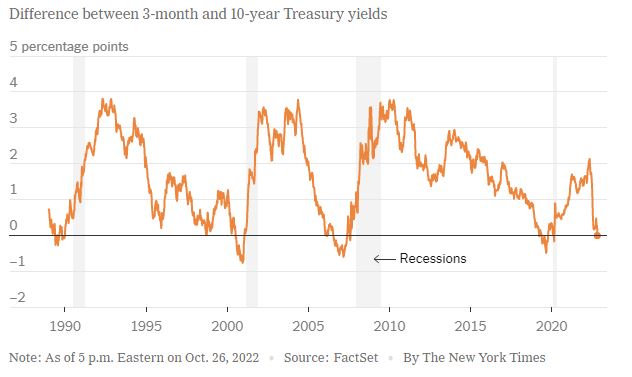
November 2022 PDS Planning Market Commentary
The Dow Jones Industrial Average had its best month since 1976 posting a return of 14% during October. Investors were hopeful comments from the Fed indicated a slowdown in inflation was on the way and therefore a slowdown to rate increases. But, as we’ve seen time and time again this year, inflation surprised economists on the high side. Fed chair Jerome Powell reiterated the central bank would “stay the course until the job is done.” Markets were quick to react, resulting in negative returns across the three major indices – S&P 500, Nasdaq, and the Dow.
At the same time the Dow was racing to recover losses, the yield curve became inverted. The yield curve represents US Treasury rates from 3-months to 30 years. A normal sloping curve is positive, where the short-term rates are less than the long-term rates. The longer the maturity, the greater risk there is to invest, and therefore the greater the expected reward. When the curve inverts, short-term rates are greater than long-term rates. In this case, a 3-month Treasury has a more attractive yield and a 10-year Treasury. Why?
When this happens, it signifies investors are pessimistic about the economy and have been rushing to buy longer term bonds for security. When the demand increases, bond prices will rise and thus yields will drop. The inversion is exacerbated by the Fed raising rates, which have a much stronger impact on short-term yields.

An inverted yield curve does not cause recession, instead it’s a representation of how investors view the economy. It’s an indicator, not a forecast. And while the curve has inverted, a lot can change in the next few months to help to avoid a possible recession.
IMPORTANT DISCLOSURE INFORMATION: Please remember that past performance is no guarantee of future results. Different types of investments involve varying degrees of risk, and there can be no assurance that the future performance of any specific investment, investment strategy, or product (including the investments and/or investment strategies recommended or undertaken by PDS Planning, Inc. [“PDS”]), or any non-investment related content, made reference to directly or indirectly in this blog will be profitable, equal any corresponding indicated historical performance level(s), be suitable for your portfolio or individual situation, or prove successful. Due to various factors, including changing market conditions and/or applicable laws, the content may no longer be reflective of current opinions or positions. Moreover, you should not assume that any discussion or information contained in this blog serves as the receipt of, or as a substitute for, personalized investment advice from PDS. To the extent that a reader has any questions regarding the applicability of any specific issue discussed above to his/her individual situation, he/she is encouraged to consult with the professional advisor of his/her choosing. PDS is neither a law firm nor a certified public accounting firm and no portion of the blog content should be construed as legal or accounting advice. A copy of the PDS’ current written disclosure Brochure discussing our advisory services and fees is available for review upon request or at www.pdsplanning.com. Please Note: PDS does not make any representations or warranties as to the accuracy, timeliness, suitability, completeness, or relevance of any information prepared by any unaffiliated third party, whether linked to PDS’ web site or blog or incorporated herein, and takes no responsibility for any such content. All such information is provided solely for convenience purposes only and all users thereof should be guided accordingly. Please Remember: If you are a PDS client, please contact PDS, in writing, if there are any changes in your personal/financial situation or investment objectives for the purpose of reviewing/evaluating/revising our previous recommendations and/or services, or if you would like to impose, add, or to modify any reasonable restrictions to our investment advisory services. Unless, and until, you notify us, in writing, to the contrary, we shall continue to provide services as we do currently. Please Also Remember to advise us if you have not been receiving account statements (at least quarterly) from the account custodian.



